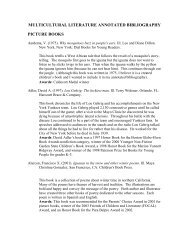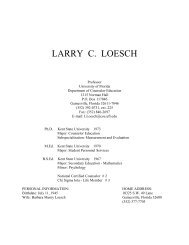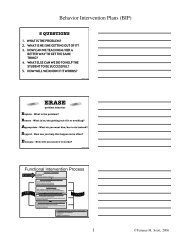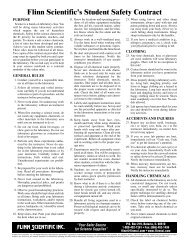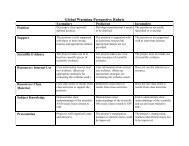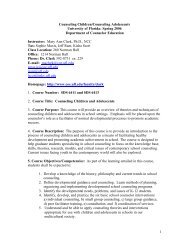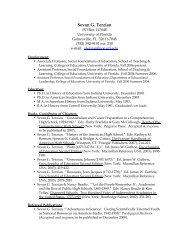The Effects of Distance Education on K-12 Student Outcomes: A ...
The Effects of Distance Education on K-12 Student Outcomes: A ...
The Effects of Distance Education on K-12 Student Outcomes: A ...
Create successful ePaper yourself
Turn your PDF publications into a flip-book with our unique Google optimized e-Paper software.
<str<strong>on</strong>g>of</str<strong>on</strong>g> invalidity. N<strong>on</strong>e <str<strong>on</strong>g>of</str<strong>on</strong>g> the variable comparis<strong>on</strong>s resulted in effect sizes significantly different<br />
from zero.<br />
<str<strong>on</strong>g>Distance</str<strong>on</strong>g> <str<strong>on</strong>g>Educati<strong>on</strong></str<strong>on</strong>g> Variables<br />
Eleven variables were used to identify the features <str<strong>on</strong>g>of</str<strong>on</strong>g> the distance educati<strong>on</strong> experience that may<br />
play a role in student performance. <str<strong>on</strong>g>The</str<strong>on</strong>g>y were durati<strong>on</strong> <str<strong>on</strong>g>of</str<strong>on</strong>g> the program, frequency <str<strong>on</strong>g>of</str<strong>on</strong>g> use <str<strong>on</strong>g>of</str<strong>on</strong>g><br />
distance learning, instructi<strong>on</strong>al role <str<strong>on</strong>g>of</str<strong>on</strong>g> the program, number <str<strong>on</strong>g>of</str<strong>on</strong>g> distance learning sessi<strong>on</strong>s,<br />
durati<strong>on</strong> <str<strong>on</strong>g>of</str<strong>on</strong>g> distance learning sessi<strong>on</strong>s, pacing <str<strong>on</strong>g>of</str<strong>on</strong>g> the instructi<strong>on</strong>, role <str<strong>on</strong>g>of</str<strong>on</strong>g> the instructor, timing <str<strong>on</strong>g>of</str<strong>on</strong>g><br />
the interacti<strong>on</strong>s, type <str<strong>on</strong>g>of</str<strong>on</strong>g> interacti<strong>on</strong>s, amount <str<strong>on</strong>g>of</str<strong>on</strong>g> teacher preparati<strong>on</strong> for distance instructi<strong>on</strong>, and<br />
amount <str<strong>on</strong>g>of</str<strong>on</strong>g> teacher experience in distance instructi<strong>on</strong>. Because <str<strong>on</strong>g>of</str<strong>on</strong>g> the individualized nature <str<strong>on</strong>g>of</str<strong>on</strong>g><br />
distance educati<strong>on</strong>, <strong>on</strong>ly two <str<strong>on</strong>g>of</str<strong>on</strong>g> the studies indicated specific numbers and durati<strong>on</strong>s <str<strong>on</strong>g>of</str<strong>on</strong>g> distance<br />
learning sessi<strong>on</strong>s, and they were studies <str<strong>on</strong>g>of</str<strong>on</strong>g> limited partial-course experiences. Half <str<strong>on</strong>g>of</str<strong>on</strong>g> the studies<br />
did not indicate whether students or instructors set the pace within the distance learning<br />
timeframe, while three <str<strong>on</strong>g>of</str<strong>on</strong>g> the programs were completely self-paced, and four were designed for<br />
students to set their pace within parameters set by the instructor. In terms <str<strong>on</strong>g>of</str<strong>on</strong>g> the role <str<strong>on</strong>g>of</str<strong>on</strong>g> the<br />
instructor in teaching, <strong>on</strong>e program was fully moderated, five were n<strong>on</strong>-moderated, four used a<br />
combinati<strong>on</strong> <str<strong>on</strong>g>of</str<strong>on</strong>g> moderated and n<strong>on</strong>-moderated activities, and four did not indicate the<br />
instructors’ role. Ten programs used a combinati<strong>on</strong> <str<strong>on</strong>g>of</str<strong>on</strong>g> interacti<strong>on</strong>s am<strong>on</strong>g students, c<strong>on</strong>tent,<br />
instructors, and others; <strong>on</strong>e limited interacti<strong>on</strong>s to student-c<strong>on</strong>tent; and three did not specify<br />
interacti<strong>on</strong> types. No studies described the levels <str<strong>on</strong>g>of</str<strong>on</strong>g> instructor preparati<strong>on</strong> or experience required<br />
<str<strong>on</strong>g>of</str<strong>on</strong>g> or possessed by the instructors. All levels <str<strong>on</strong>g>of</str<strong>on</strong>g> each distance educati<strong>on</strong> variable had effect sizes<br />
not significantly different from zero.<br />
Instructi<strong>on</strong>al and Program Variables<br />
<str<strong>on</strong>g>The</str<strong>on</strong>g> five variables that indicated the extent to which instructi<strong>on</strong>al and program factors played a<br />
role in student outcomes were grade level, school type, c<strong>on</strong>tent area, the qualificati<strong>on</strong>s <str<strong>on</strong>g>of</str<strong>on</strong>g> the<br />
teacher in the teaching field, and the setting <str<strong>on</strong>g>of</str<strong>on</strong>g> the students. Twelve <str<strong>on</strong>g>of</str<strong>on</strong>g> the studies indicated that<br />
the instructors were certified teachers, and the other two studies did not describe the credentials<br />
<str<strong>on</strong>g>of</str<strong>on</strong>g> the instructors. In five <str<strong>on</strong>g>of</str<strong>on</strong>g> the programs, students participated from home or a n<strong>on</strong>-school<br />
locati<strong>on</strong>, four programs are designed such that students completed some work from home and<br />
some in a school setting, in three programs, students did their distance learning work while at a<br />
school, and two programs did not specify the setting <str<strong>on</strong>g>of</str<strong>on</strong>g> the students. All instructi<strong>on</strong>al and<br />
program factors had effect sizes that were effectively zero.<br />
Discussi<strong>on</strong><br />
<str<strong>on</strong>g>The</str<strong>on</strong>g> literature reviewed in this meta-analysis includes results from 116 comparis<strong>on</strong>s <str<strong>on</strong>g>of</str<strong>on</strong>g> grades 3-<br />
<strong>12</strong> web-based distance educati<strong>on</strong> programs with classroom-based teaching, including data for<br />
7561 students. <str<strong>on</strong>g>The</str<strong>on</strong>g> questi<strong>on</strong>s <str<strong>on</strong>g>of</str<strong>on</strong>g> the effectiveness <str<strong>on</strong>g>of</str<strong>on</strong>g> distance educati<strong>on</strong> for K-<strong>12</strong> student<br />
performance, and <str<strong>on</strong>g>of</str<strong>on</strong>g> the factors influencing its effectiveness were addressed using fixed-effects<br />
effect size estimati<strong>on</strong>. <str<strong>on</strong>g>The</str<strong>on</strong>g> findings c<strong>on</strong>firm those <str<strong>on</strong>g>of</str<strong>on</strong>g> other recent meta-analyses <str<strong>on</strong>g>of</str<strong>on</strong>g> distance<br />
educati<strong>on</strong> programs, and provide a needed update to the meta-analysis focused <strong>on</strong> K-<strong>12</strong> students<br />
15 <str<strong>on</strong>g>of</str<strong>on</strong>g> 32



